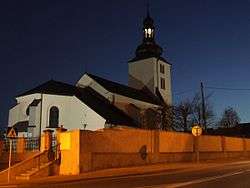Lipsko
Lipsko [ˈlʲipskɔ] is a town in Poland, in northern Lesser Poland, Mazowsze Voivodship. It is the capital of Lipsko County. The population is 5,895 (2004). Lipsko’s coat of arms is the Dębno, which was used by previous owners of the town.
Lipsko | |
|---|---|
 Holy Trinity church in Lipsko | |
 Coat of arms | |
 Lipsko | |
| Coordinates: 51°9′24″N 21°39′27″E | |
| Country | |
| Voivodeship | Masovian |
| County | Lipsko County |
| Gmina | Gmina Lipsko |
| Established | 16th century |
| Town rights | 1613 |
| Government | |
| • Mayor | Jacek Wielorański |
| Area | |
| • Total | 15.7 km2 (6.1 sq mi) |
| Population (2006) | |
| • Total | 5,826 |
| • Density | 370/km2 (960/sq mi) |
| Time zone | UTC+1 (CET) |
| • Summer (DST) | UTC+2 (CEST) |
| Postal code | 27-300 |
| Area code(s) | +48 48 |
| Car plates | WLI |
| Website | http://www.lipsko.eu |
Lipsko is located on two hills, divided by the Krępianka river. First mention about it comes from April 1589, when the village belonged to the Krępski family. In 1613 it was granted town rights, and quickly developed, due to the location along the “oxen road”, from Red Ruthenia to Greater Poland and Silesia. In 1614, Holy Trinity Church was built, founded by Lord Mikołaj Oleśnicki. In the 18th century Lipsko, located in Sandomierz Voivodeship belonged to several families - the Denhoffs, the Sanguszkos, and the Kochanowskis. After the Partitions of Poland, the town stagnated, with the population not more than 100. In 1868, as a punishment for participation of residents in the January Uprising, the Russians took away Lipsko’s town rights, turning it into a village (Lipsko did not become a town again until 1958).
During World War II, German occupiers committed mass murders and brutalized both the Christian and Jewish population. At the beginning of the war, about 1600 Jews lived in Lipsko, half the population. When the Germans occupied the town, on September 8, 1939, they shot several Jews, including the rabbi, and then burned alive 60 to 80 Jews in the synagogue. Later the Jewish population was forced into a ghetto and Jews from surrounding villages were brought there too. By October 1942, there were 3600 Jews in the ghetto. Lipsko was conveniently, for the Germans, located near a railway line. Some Jews were deported to forced labor camps, but in mid October 1942, the rest of the Jewish population were rounded up by German police and Ukrainian auxiliary guards. A few escaped to hide with Gentile friends or join the partisans. Most were transported to the Tarlow ghetto and then on to Treblinka, where they were murdered on arrival by gas. The number of Jewish survivors from Lipsko is unknown.[1]
On January 1, 1956, Lipsko became the seat of a county in Kielce Voivodeship. The town is home to a sports club Powiślanka, founded in 1964.
References
- m, Geoffrey (2012). Encyclopedia of Camps and Ghettos. Bloomington, Indiana: University of Indiana Press. p. Volume II 254–255. ISBN 978-0-253-35599-7.
External links
- Official town webpage
- Jewish Community in Lipsko on Virtual Shtetl
| Wikimedia Commons has media related to Lipsko. |
